Analyzing Eating Out: Nutrition, Sustainability, and Food Environment
VerifiedAdded on 2023/04/23
|10
|2723
|327
Report
AI Summary
This report examines the multifaceted impacts of "eating out" on various aspects of nutrition, health, and sustainability, particularly within the Canadian context. It explores the current eating out habits in Canada and their nutritional implications, highlighting the prevalence of obesity and nutrition-deficient food choices. The relationship between eating out and global nutrition is analyzed, emphasizing the role of economic development and the increasing consumption of fast foods. The report also delves into how eating out affects the food environment and overall wellness, focusing on consumer-based approaches and the importance of informed choices. Furthermore, it investigates whether eating out contributes to a sustainable diet, considering the challenges of global food consumption and food waste. Finally, the report addresses the impact of eating out on food security, linking it to resource depletion and environmental changes, and acknowledges the Canadian government's efforts to mitigate these issues. The analysis concludes that while eating out is a prevalent lifestyle choice, it has significant implications for global nutrition, sustainable diets, and food security, underscoring the need for increased awareness and informed food consumption practices.
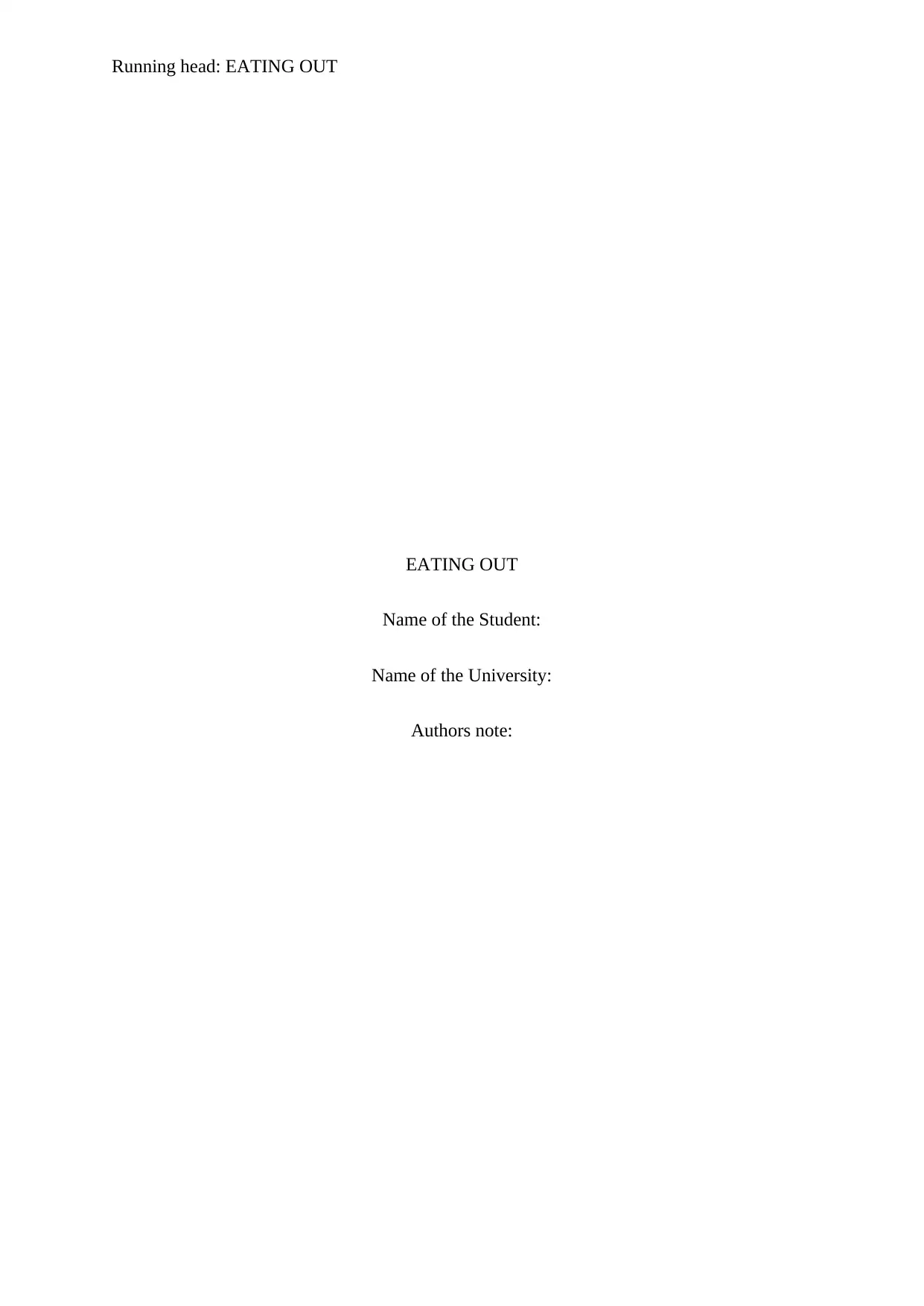
Running head: EATING OUT
EATING OUT
Name of the Student:
Name of the University:
Authors note:
EATING OUT
Name of the Student:
Name of the University:
Authors note:
Paraphrase This Document
Need a fresh take? Get an instant paraphrase of this document with our AI Paraphraser
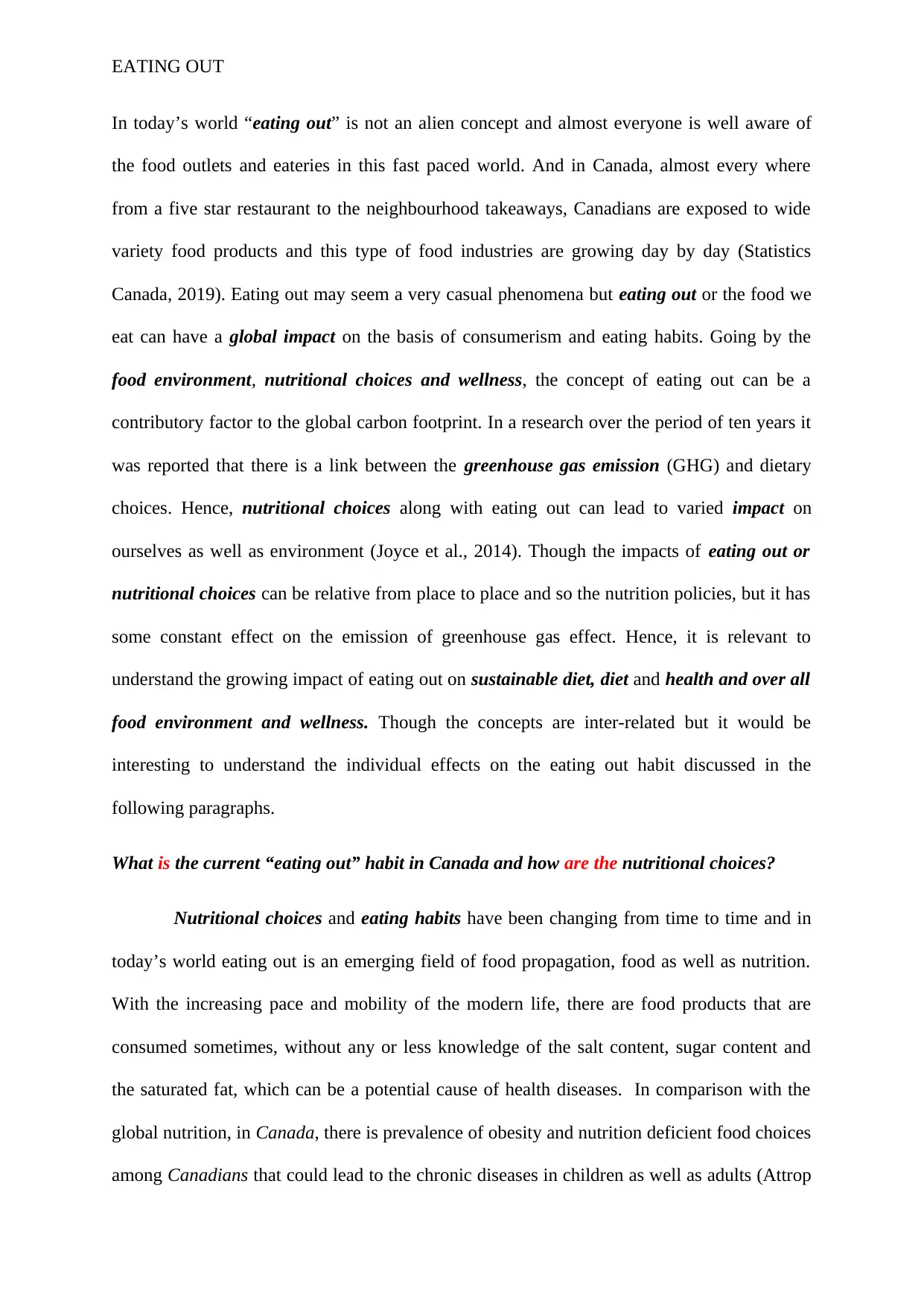
EATING OUT
In today’s world “eating out” is not an alien concept and almost everyone is well aware of
the food outlets and eateries in this fast paced world. And in Canada, almost every where
from a five star restaurant to the neighbourhood takeaways, Canadians are exposed to wide
variety food products and this type of food industries are growing day by day (Statistics
Canada, 2019). Eating out may seem a very casual phenomena but eating out or the food we
eat can have a global impact on the basis of consumerism and eating habits. Going by the
food environment, nutritional choices and wellness, the concept of eating out can be a
contributory factor to the global carbon footprint. In a research over the period of ten years it
was reported that there is a link between the greenhouse gas emission (GHG) and dietary
choices. Hence, nutritional choices along with eating out can lead to varied impact on
ourselves as well as environment (Joyce et al., 2014). Though the impacts of eating out or
nutritional choices can be relative from place to place and so the nutrition policies, but it has
some constant effect on the emission of greenhouse gas effect. Hence, it is relevant to
understand the growing impact of eating out on sustainable diet, diet and health and over all
food environment and wellness. Though the concepts are inter-related but it would be
interesting to understand the individual effects on the eating out habit discussed in the
following paragraphs.
What is the current “eating out” habit in Canada and how are the nutritional choices?
Nutritional choices and eating habits have been changing from time to time and in
today’s world eating out is an emerging field of food propagation, food as well as nutrition.
With the increasing pace and mobility of the modern life, there are food products that are
consumed sometimes, without any or less knowledge of the salt content, sugar content and
the saturated fat, which can be a potential cause of health diseases. In comparison with the
global nutrition, in Canada, there is prevalence of obesity and nutrition deficient food choices
among Canadians that could lead to the chronic diseases in children as well as adults (Attrop
In today’s world “eating out” is not an alien concept and almost everyone is well aware of
the food outlets and eateries in this fast paced world. And in Canada, almost every where
from a five star restaurant to the neighbourhood takeaways, Canadians are exposed to wide
variety food products and this type of food industries are growing day by day (Statistics
Canada, 2019). Eating out may seem a very casual phenomena but eating out or the food we
eat can have a global impact on the basis of consumerism and eating habits. Going by the
food environment, nutritional choices and wellness, the concept of eating out can be a
contributory factor to the global carbon footprint. In a research over the period of ten years it
was reported that there is a link between the greenhouse gas emission (GHG) and dietary
choices. Hence, nutritional choices along with eating out can lead to varied impact on
ourselves as well as environment (Joyce et al., 2014). Though the impacts of eating out or
nutritional choices can be relative from place to place and so the nutrition policies, but it has
some constant effect on the emission of greenhouse gas effect. Hence, it is relevant to
understand the growing impact of eating out on sustainable diet, diet and health and over all
food environment and wellness. Though the concepts are inter-related but it would be
interesting to understand the individual effects on the eating out habit discussed in the
following paragraphs.
What is the current “eating out” habit in Canada and how are the nutritional choices?
Nutritional choices and eating habits have been changing from time to time and in
today’s world eating out is an emerging field of food propagation, food as well as nutrition.
With the increasing pace and mobility of the modern life, there are food products that are
consumed sometimes, without any or less knowledge of the salt content, sugar content and
the saturated fat, which can be a potential cause of health diseases. In comparison with the
global nutrition, in Canada, there is prevalence of obesity and nutrition deficient food choices
among Canadians that could lead to the chronic diseases in children as well as adults (Attrop
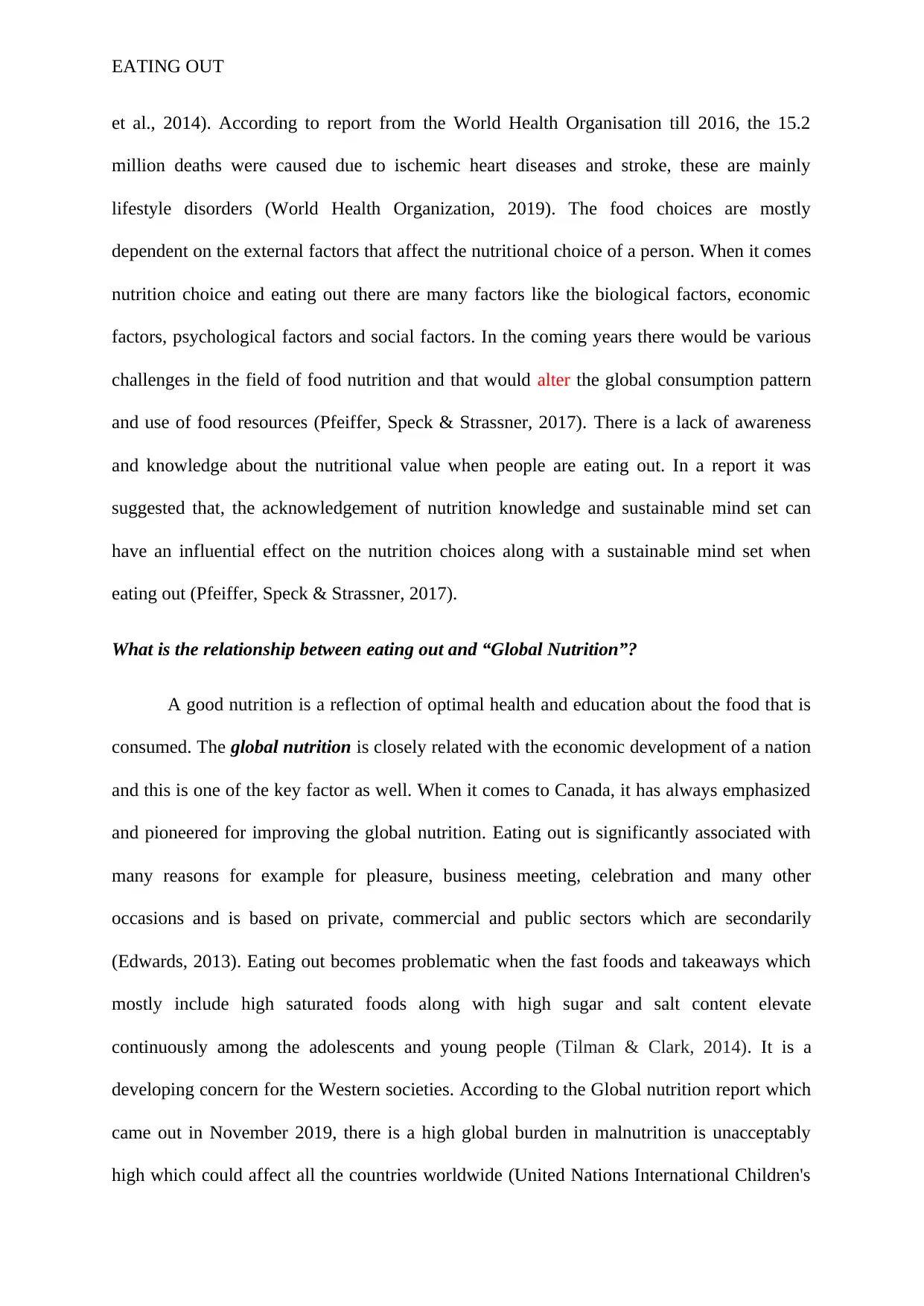
EATING OUT
et al., 2014). According to report from the World Health Organisation till 2016, the 15.2
million deaths were caused due to ischemic heart diseases and stroke, these are mainly
lifestyle disorders (World Health Organization, 2019). The food choices are mostly
dependent on the external factors that affect the nutritional choice of a person. When it comes
nutrition choice and eating out there are many factors like the biological factors, economic
factors, psychological factors and social factors. In the coming years there would be various
challenges in the field of food nutrition and that would alter the global consumption pattern
and use of food resources (Pfeiffer, Speck & Strassner, 2017). There is a lack of awareness
and knowledge about the nutritional value when people are eating out. In a report it was
suggested that, the acknowledgement of nutrition knowledge and sustainable mind set can
have an influential effect on the nutrition choices along with a sustainable mind set when
eating out (Pfeiffer, Speck & Strassner, 2017).
What is the relationship between eating out and “Global Nutrition”?
A good nutrition is a reflection of optimal health and education about the food that is
consumed. The global nutrition is closely related with the economic development of a nation
and this is one of the key factor as well. When it comes to Canada, it has always emphasized
and pioneered for improving the global nutrition. Eating out is significantly associated with
many reasons for example for pleasure, business meeting, celebration and many other
occasions and is based on private, commercial and public sectors which are secondarily
(Edwards, 2013). Eating out becomes problematic when the fast foods and takeaways which
mostly include high saturated foods along with high sugar and salt content elevate
continuously among the adolescents and young people (Tilman & Clark, 2014). It is a
developing concern for the Western societies. According to the Global nutrition report which
came out in November 2019, there is a high global burden in malnutrition is unacceptably
high which could affect all the countries worldwide (United Nations International Children's
et al., 2014). According to report from the World Health Organisation till 2016, the 15.2
million deaths were caused due to ischemic heart diseases and stroke, these are mainly
lifestyle disorders (World Health Organization, 2019). The food choices are mostly
dependent on the external factors that affect the nutritional choice of a person. When it comes
nutrition choice and eating out there are many factors like the biological factors, economic
factors, psychological factors and social factors. In the coming years there would be various
challenges in the field of food nutrition and that would alter the global consumption pattern
and use of food resources (Pfeiffer, Speck & Strassner, 2017). There is a lack of awareness
and knowledge about the nutritional value when people are eating out. In a report it was
suggested that, the acknowledgement of nutrition knowledge and sustainable mind set can
have an influential effect on the nutrition choices along with a sustainable mind set when
eating out (Pfeiffer, Speck & Strassner, 2017).
What is the relationship between eating out and “Global Nutrition”?
A good nutrition is a reflection of optimal health and education about the food that is
consumed. The global nutrition is closely related with the economic development of a nation
and this is one of the key factor as well. When it comes to Canada, it has always emphasized
and pioneered for improving the global nutrition. Eating out is significantly associated with
many reasons for example for pleasure, business meeting, celebration and many other
occasions and is based on private, commercial and public sectors which are secondarily
(Edwards, 2013). Eating out becomes problematic when the fast foods and takeaways which
mostly include high saturated foods along with high sugar and salt content elevate
continuously among the adolescents and young people (Tilman & Clark, 2014). It is a
developing concern for the Western societies. According to the Global nutrition report which
came out in November 2019, there is a high global burden in malnutrition is unacceptably
high which could affect all the countries worldwide (United Nations International Children's
⊘ This is a preview!⊘
Do you want full access?
Subscribe today to unlock all pages.

Trusted by 1+ million students worldwide
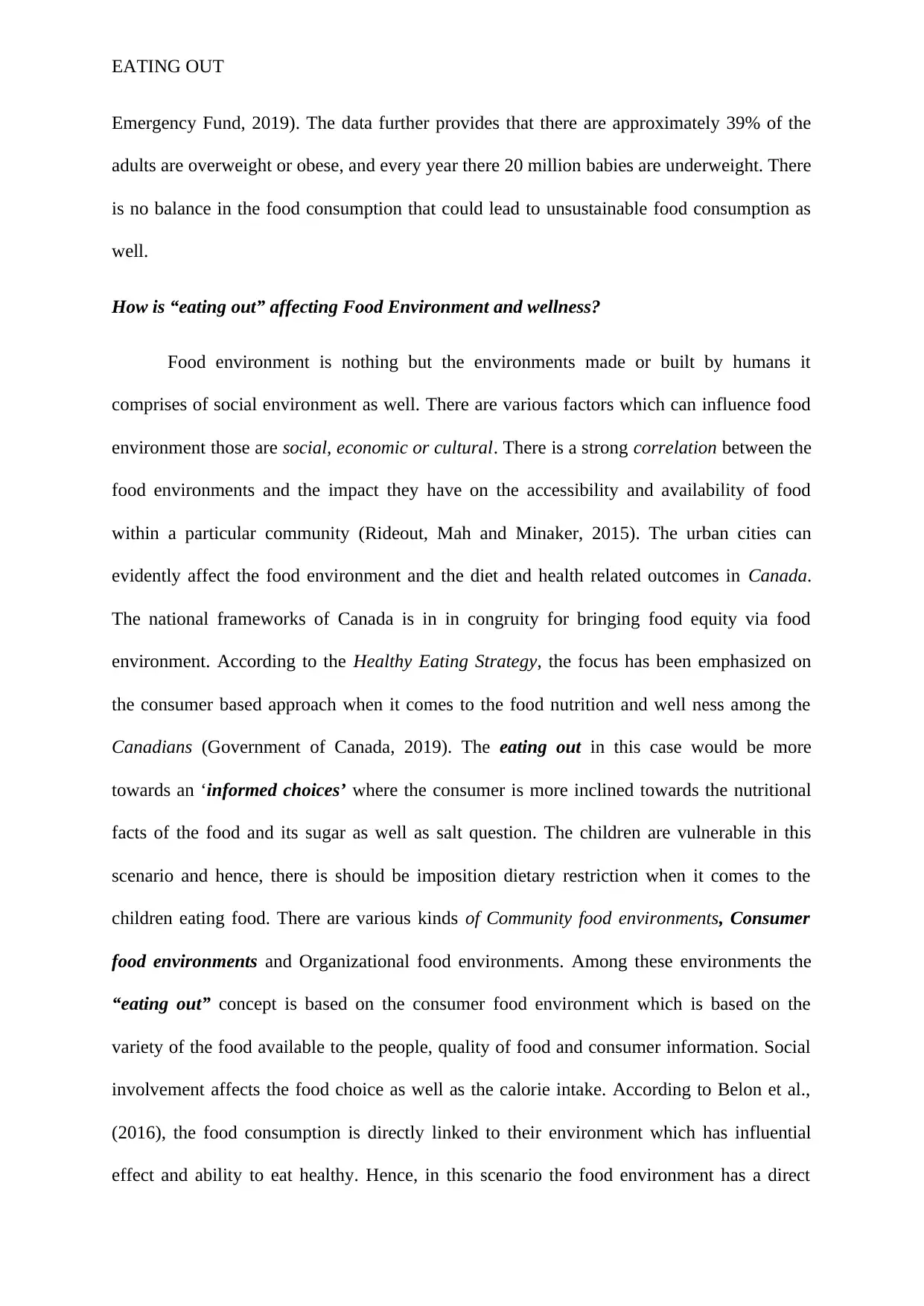
EATING OUT
Emergency Fund, 2019). The data further provides that there are approximately 39% of the
adults are overweight or obese, and every year there 20 million babies are underweight. There
is no balance in the food consumption that could lead to unsustainable food consumption as
well.
How is “eating out” affecting Food Environment and wellness?
Food environment is nothing but the environments made or built by humans it
comprises of social environment as well. There are various factors which can influence food
environment those are social, economic or cultural. There is a strong correlation between the
food environments and the impact they have on the accessibility and availability of food
within a particular community (Rideout, Mah and Minaker, 2015). The urban cities can
evidently affect the food environment and the diet and health related outcomes in Canada.
The national frameworks of Canada is in in congruity for bringing food equity via food
environment. According to the Healthy Eating Strategy, the focus has been emphasized on
the consumer based approach when it comes to the food nutrition and well ness among the
Canadians (Government of Canada, 2019). The eating out in this case would be more
towards an ‘informed choices’ where the consumer is more inclined towards the nutritional
facts of the food and its sugar as well as salt question. The children are vulnerable in this
scenario and hence, there is should be imposition dietary restriction when it comes to the
children eating food. There are various kinds of Community food environments, Consumer
food environments and Organizational food environments. Among these environments the
“eating out” concept is based on the consumer food environment which is based on the
variety of the food available to the people, quality of food and consumer information. Social
involvement affects the food choice as well as the calorie intake. According to Belon et al.,
(2016), the food consumption is directly linked to their environment which has influential
effect and ability to eat healthy. Hence, in this scenario the food environment has a direct
Emergency Fund, 2019). The data further provides that there are approximately 39% of the
adults are overweight or obese, and every year there 20 million babies are underweight. There
is no balance in the food consumption that could lead to unsustainable food consumption as
well.
How is “eating out” affecting Food Environment and wellness?
Food environment is nothing but the environments made or built by humans it
comprises of social environment as well. There are various factors which can influence food
environment those are social, economic or cultural. There is a strong correlation between the
food environments and the impact they have on the accessibility and availability of food
within a particular community (Rideout, Mah and Minaker, 2015). The urban cities can
evidently affect the food environment and the diet and health related outcomes in Canada.
The national frameworks of Canada is in in congruity for bringing food equity via food
environment. According to the Healthy Eating Strategy, the focus has been emphasized on
the consumer based approach when it comes to the food nutrition and well ness among the
Canadians (Government of Canada, 2019). The eating out in this case would be more
towards an ‘informed choices’ where the consumer is more inclined towards the nutritional
facts of the food and its sugar as well as salt question. The children are vulnerable in this
scenario and hence, there is should be imposition dietary restriction when it comes to the
children eating food. There are various kinds of Community food environments, Consumer
food environments and Organizational food environments. Among these environments the
“eating out” concept is based on the consumer food environment which is based on the
variety of the food available to the people, quality of food and consumer information. Social
involvement affects the food choice as well as the calorie intake. According to Belon et al.,
(2016), the food consumption is directly linked to their environment which has influential
effect and ability to eat healthy. Hence, in this scenario the food environment has a direct
Paraphrase This Document
Need a fresh take? Get an instant paraphrase of this document with our AI Paraphraser
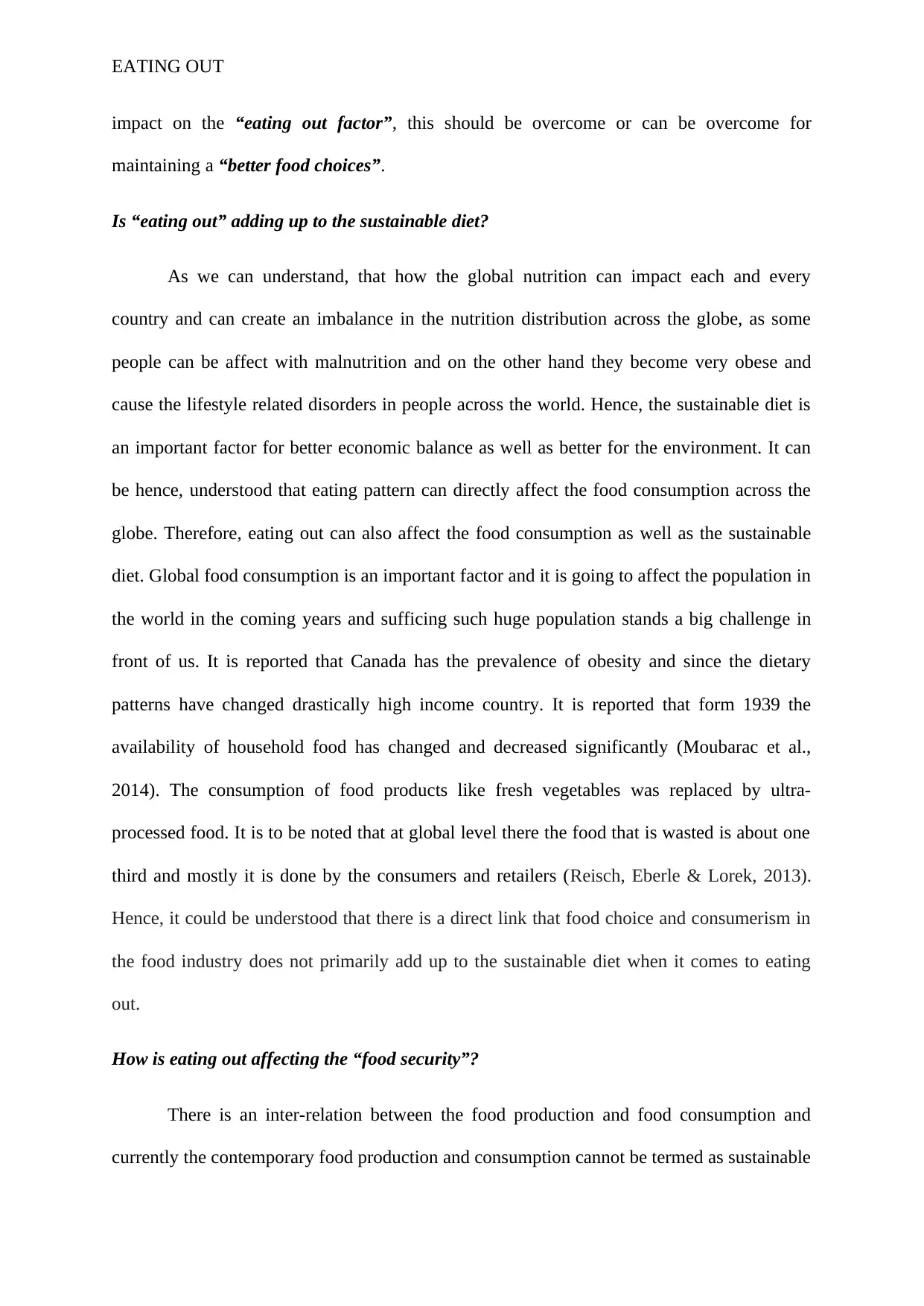
EATING OUT
impact on the “eating out factor”, this should be overcome or can be overcome for
maintaining a “better food choices”.
Is “eating out” adding up to the sustainable diet?
As we can understand, that how the global nutrition can impact each and every
country and can create an imbalance in the nutrition distribution across the globe, as some
people can be affect with malnutrition and on the other hand they become very obese and
cause the lifestyle related disorders in people across the world. Hence, the sustainable diet is
an important factor for better economic balance as well as better for the environment. It can
be hence, understood that eating pattern can directly affect the food consumption across the
globe. Therefore, eating out can also affect the food consumption as well as the sustainable
diet. Global food consumption is an important factor and it is going to affect the population in
the world in the coming years and sufficing such huge population stands a big challenge in
front of us. It is reported that Canada has the prevalence of obesity and since the dietary
patterns have changed drastically high income country. It is reported that form 1939 the
availability of household food has changed and decreased significantly (Moubarac et al.,
2014). The consumption of food products like fresh vegetables was replaced by ultra-
processed food. It is to be noted that at global level there the food that is wasted is about one
third and mostly it is done by the consumers and retailers (Reisch, Eberle & Lorek, 2013).
Hence, it could be understood that there is a direct link that food choice and consumerism in
the food industry does not primarily add up to the sustainable diet when it comes to eating
out.
How is eating out affecting the “food security”?
There is an inter-relation between the food production and food consumption and
currently the contemporary food production and consumption cannot be termed as sustainable
impact on the “eating out factor”, this should be overcome or can be overcome for
maintaining a “better food choices”.
Is “eating out” adding up to the sustainable diet?
As we can understand, that how the global nutrition can impact each and every
country and can create an imbalance in the nutrition distribution across the globe, as some
people can be affect with malnutrition and on the other hand they become very obese and
cause the lifestyle related disorders in people across the world. Hence, the sustainable diet is
an important factor for better economic balance as well as better for the environment. It can
be hence, understood that eating pattern can directly affect the food consumption across the
globe. Therefore, eating out can also affect the food consumption as well as the sustainable
diet. Global food consumption is an important factor and it is going to affect the population in
the world in the coming years and sufficing such huge population stands a big challenge in
front of us. It is reported that Canada has the prevalence of obesity and since the dietary
patterns have changed drastically high income country. It is reported that form 1939 the
availability of household food has changed and decreased significantly (Moubarac et al.,
2014). The consumption of food products like fresh vegetables was replaced by ultra-
processed food. It is to be noted that at global level there the food that is wasted is about one
third and mostly it is done by the consumers and retailers (Reisch, Eberle & Lorek, 2013).
Hence, it could be understood that there is a direct link that food choice and consumerism in
the food industry does not primarily add up to the sustainable diet when it comes to eating
out.
How is eating out affecting the “food security”?
There is an inter-relation between the food production and food consumption and
currently the contemporary food production and consumption cannot be termed as sustainable
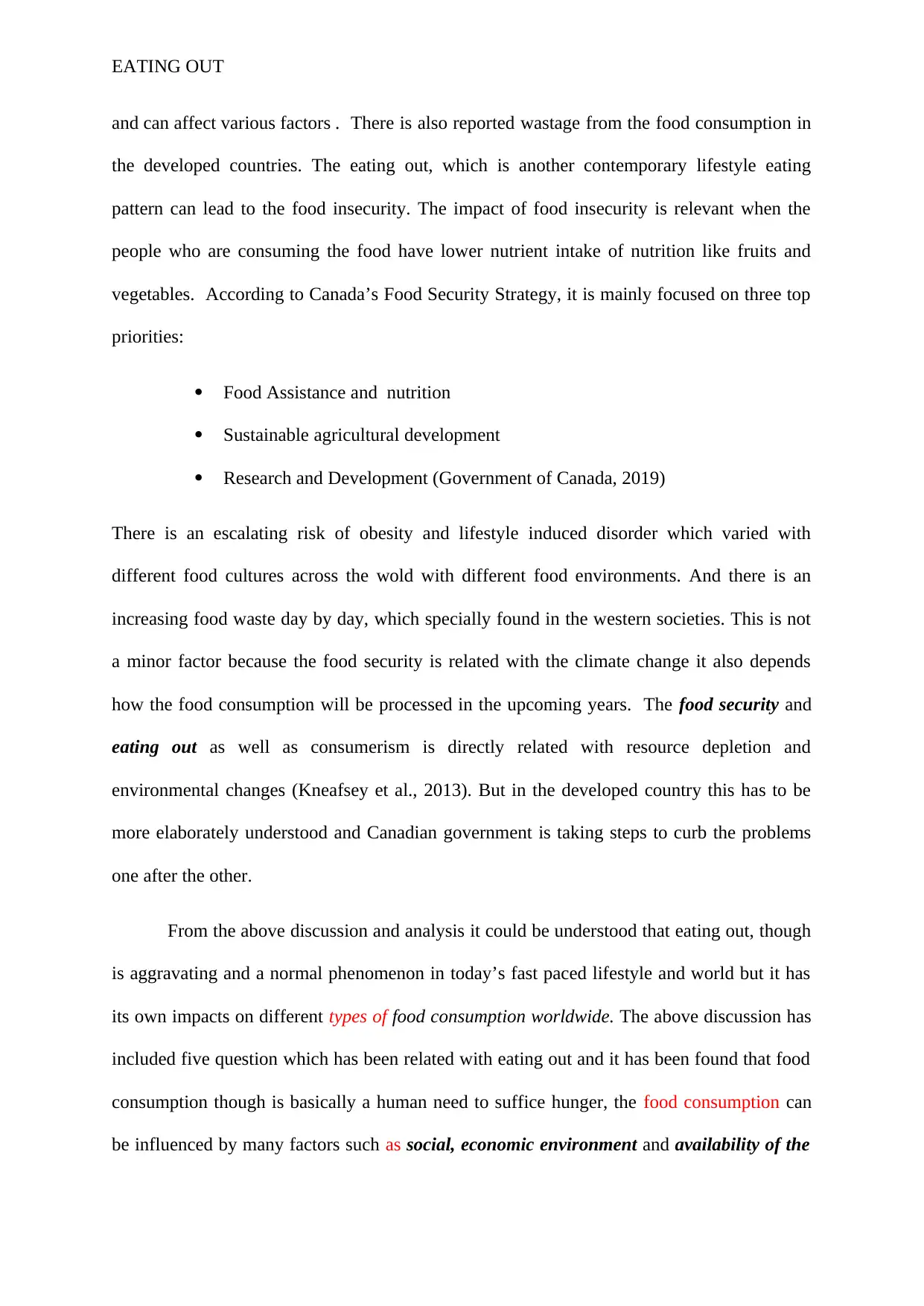
EATING OUT
and can affect various factors . There is also reported wastage from the food consumption in
the developed countries. The eating out, which is another contemporary lifestyle eating
pattern can lead to the food insecurity. The impact of food insecurity is relevant when the
people who are consuming the food have lower nutrient intake of nutrition like fruits and
vegetables. According to Canada’s Food Security Strategy, it is mainly focused on three top
priorities:
Food Assistance and nutrition
Sustainable agricultural development
Research and Development (Government of Canada, 2019)
There is an escalating risk of obesity and lifestyle induced disorder which varied with
different food cultures across the wold with different food environments. And there is an
increasing food waste day by day, which specially found in the western societies. This is not
a minor factor because the food security is related with the climate change it also depends
how the food consumption will be processed in the upcoming years. The food security and
eating out as well as consumerism is directly related with resource depletion and
environmental changes (Kneafsey et al., 2013). But in the developed country this has to be
more elaborately understood and Canadian government is taking steps to curb the problems
one after the other.
From the above discussion and analysis it could be understood that eating out, though
is aggravating and a normal phenomenon in today’s fast paced lifestyle and world but it has
its own impacts on different types of food consumption worldwide. The above discussion has
included five question which has been related with eating out and it has been found that food
consumption though is basically a human need to suffice hunger, the food consumption can
be influenced by many factors such as social, economic environment and availability of the
and can affect various factors . There is also reported wastage from the food consumption in
the developed countries. The eating out, which is another contemporary lifestyle eating
pattern can lead to the food insecurity. The impact of food insecurity is relevant when the
people who are consuming the food have lower nutrient intake of nutrition like fruits and
vegetables. According to Canada’s Food Security Strategy, it is mainly focused on three top
priorities:
Food Assistance and nutrition
Sustainable agricultural development
Research and Development (Government of Canada, 2019)
There is an escalating risk of obesity and lifestyle induced disorder which varied with
different food cultures across the wold with different food environments. And there is an
increasing food waste day by day, which specially found in the western societies. This is not
a minor factor because the food security is related with the climate change it also depends
how the food consumption will be processed in the upcoming years. The food security and
eating out as well as consumerism is directly related with resource depletion and
environmental changes (Kneafsey et al., 2013). But in the developed country this has to be
more elaborately understood and Canadian government is taking steps to curb the problems
one after the other.
From the above discussion and analysis it could be understood that eating out, though
is aggravating and a normal phenomenon in today’s fast paced lifestyle and world but it has
its own impacts on different types of food consumption worldwide. The above discussion has
included five question which has been related with eating out and it has been found that food
consumption though is basically a human need to suffice hunger, the food consumption can
be influenced by many factors such as social, economic environment and availability of the
⊘ This is a preview!⊘
Do you want full access?
Subscribe today to unlock all pages.

Trusted by 1+ million students worldwide
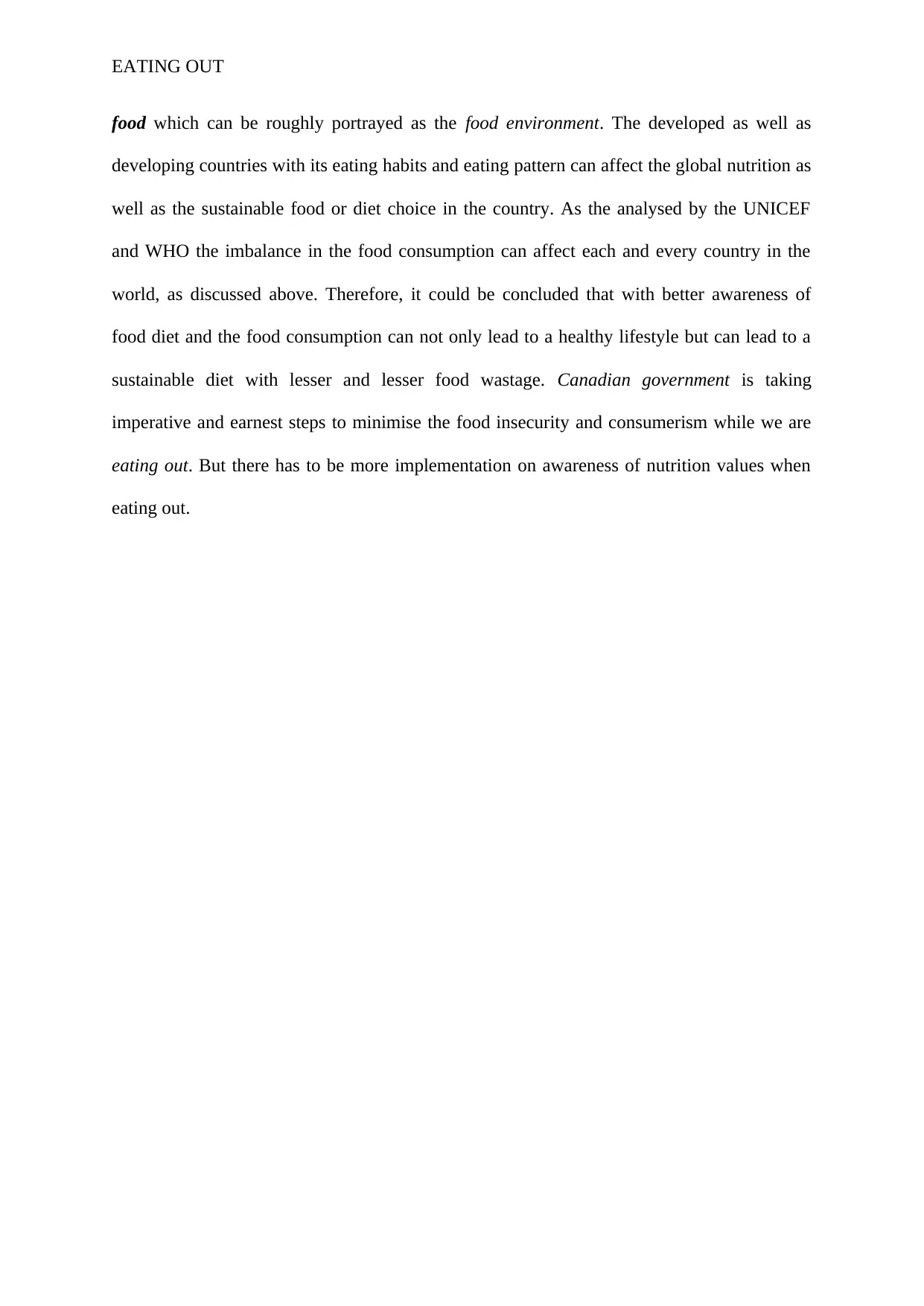
EATING OUT
food which can be roughly portrayed as the food environment. The developed as well as
developing countries with its eating habits and eating pattern can affect the global nutrition as
well as the sustainable food or diet choice in the country. As the analysed by the UNICEF
and WHO the imbalance in the food consumption can affect each and every country in the
world, as discussed above. Therefore, it could be concluded that with better awareness of
food diet and the food consumption can not only lead to a healthy lifestyle but can lead to a
sustainable diet with lesser and lesser food wastage. Canadian government is taking
imperative and earnest steps to minimise the food insecurity and consumerism while we are
eating out. But there has to be more implementation on awareness of nutrition values when
eating out.
food which can be roughly portrayed as the food environment. The developed as well as
developing countries with its eating habits and eating pattern can affect the global nutrition as
well as the sustainable food or diet choice in the country. As the analysed by the UNICEF
and WHO the imbalance in the food consumption can affect each and every country in the
world, as discussed above. Therefore, it could be concluded that with better awareness of
food diet and the food consumption can not only lead to a healthy lifestyle but can lead to a
sustainable diet with lesser and lesser food wastage. Canadian government is taking
imperative and earnest steps to minimise the food insecurity and consumerism while we are
eating out. But there has to be more implementation on awareness of nutrition values when
eating out.
Paraphrase This Document
Need a fresh take? Get an instant paraphrase of this document with our AI Paraphraser
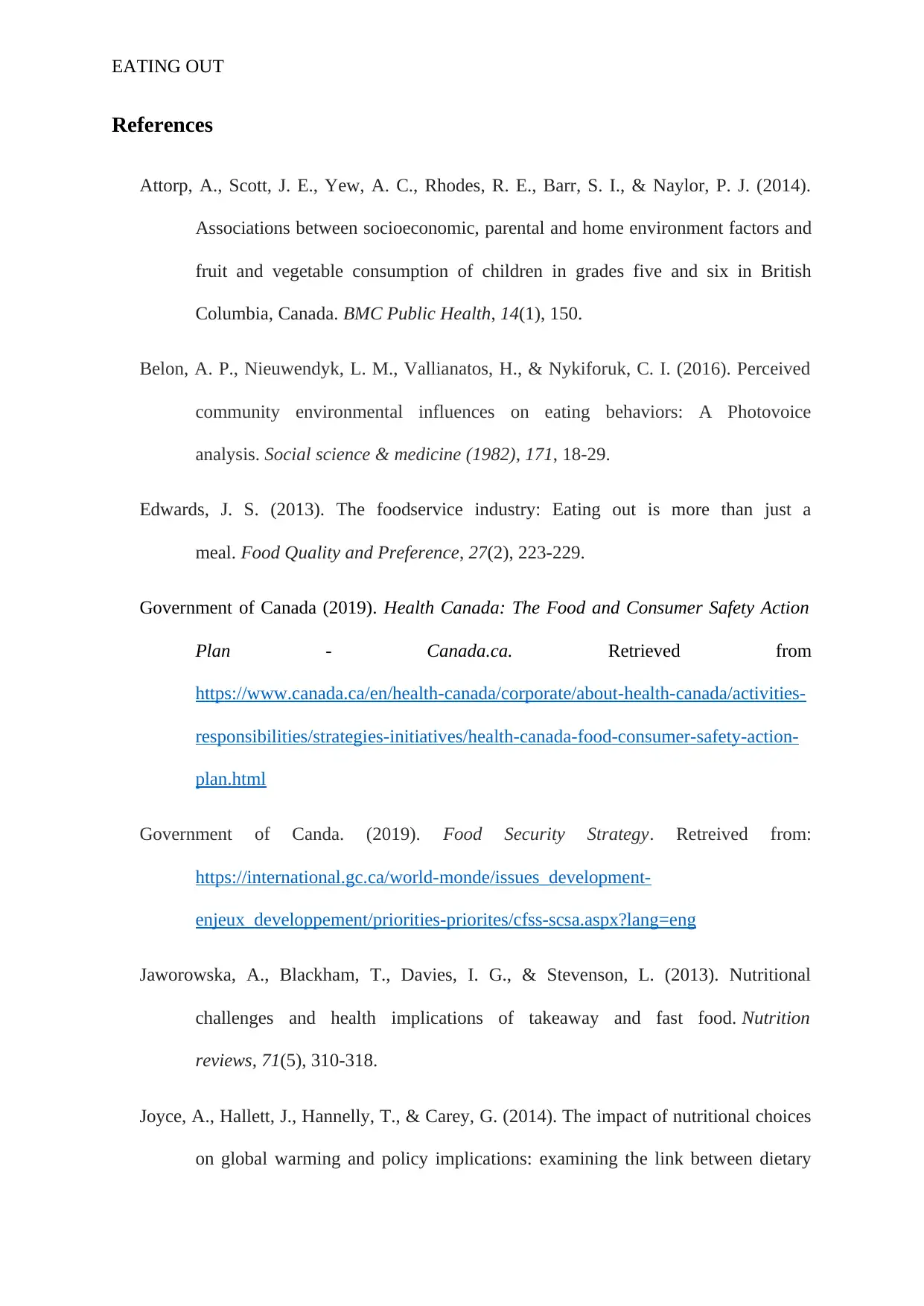
EATING OUT
References
Attorp, A., Scott, J. E., Yew, A. C., Rhodes, R. E., Barr, S. I., & Naylor, P. J. (2014).
Associations between socioeconomic, parental and home environment factors and
fruit and vegetable consumption of children in grades five and six in British
Columbia, Canada. BMC Public Health, 14(1), 150.
Belon, A. P., Nieuwendyk, L. M., Vallianatos, H., & Nykiforuk, C. I. (2016). Perceived
community environmental influences on eating behaviors: A Photovoice
analysis. Social science & medicine (1982), 171, 18-29.
Edwards, J. S. (2013). The foodservice industry: Eating out is more than just a
meal. Food Quality and Preference, 27(2), 223-229.
Government of Canada (2019). Health Canada: The Food and Consumer Safety Action
Plan - Canada.ca. Retrieved from
https://www.canada.ca/en/health-canada/corporate/about-health-canada/activities-
responsibilities/strategies-initiatives/health-canada-food-consumer-safety-action-
plan.html
Government of Canda. (2019). Food Security Strategy. Retreived from:
https://international.gc.ca/world-monde/issues_development-
enjeux_developpement/priorities-priorites/cfss-scsa.aspx?lang=eng
Jaworowska, A., Blackham, T., Davies, I. G., & Stevenson, L. (2013). Nutritional
challenges and health implications of takeaway and fast food. Nutrition
reviews, 71(5), 310-318.
Joyce, A., Hallett, J., Hannelly, T., & Carey, G. (2014). The impact of nutritional choices
on global warming and policy implications: examining the link between dietary
References
Attorp, A., Scott, J. E., Yew, A. C., Rhodes, R. E., Barr, S. I., & Naylor, P. J. (2014).
Associations between socioeconomic, parental and home environment factors and
fruit and vegetable consumption of children in grades five and six in British
Columbia, Canada. BMC Public Health, 14(1), 150.
Belon, A. P., Nieuwendyk, L. M., Vallianatos, H., & Nykiforuk, C. I. (2016). Perceived
community environmental influences on eating behaviors: A Photovoice
analysis. Social science & medicine (1982), 171, 18-29.
Edwards, J. S. (2013). The foodservice industry: Eating out is more than just a
meal. Food Quality and Preference, 27(2), 223-229.
Government of Canada (2019). Health Canada: The Food and Consumer Safety Action
Plan - Canada.ca. Retrieved from
https://www.canada.ca/en/health-canada/corporate/about-health-canada/activities-
responsibilities/strategies-initiatives/health-canada-food-consumer-safety-action-
plan.html
Government of Canda. (2019). Food Security Strategy. Retreived from:
https://international.gc.ca/world-monde/issues_development-
enjeux_developpement/priorities-priorites/cfss-scsa.aspx?lang=eng
Jaworowska, A., Blackham, T., Davies, I. G., & Stevenson, L. (2013). Nutritional
challenges and health implications of takeaway and fast food. Nutrition
reviews, 71(5), 310-318.
Joyce, A., Hallett, J., Hannelly, T., & Carey, G. (2014). The impact of nutritional choices
on global warming and policy implications: examining the link between dietary
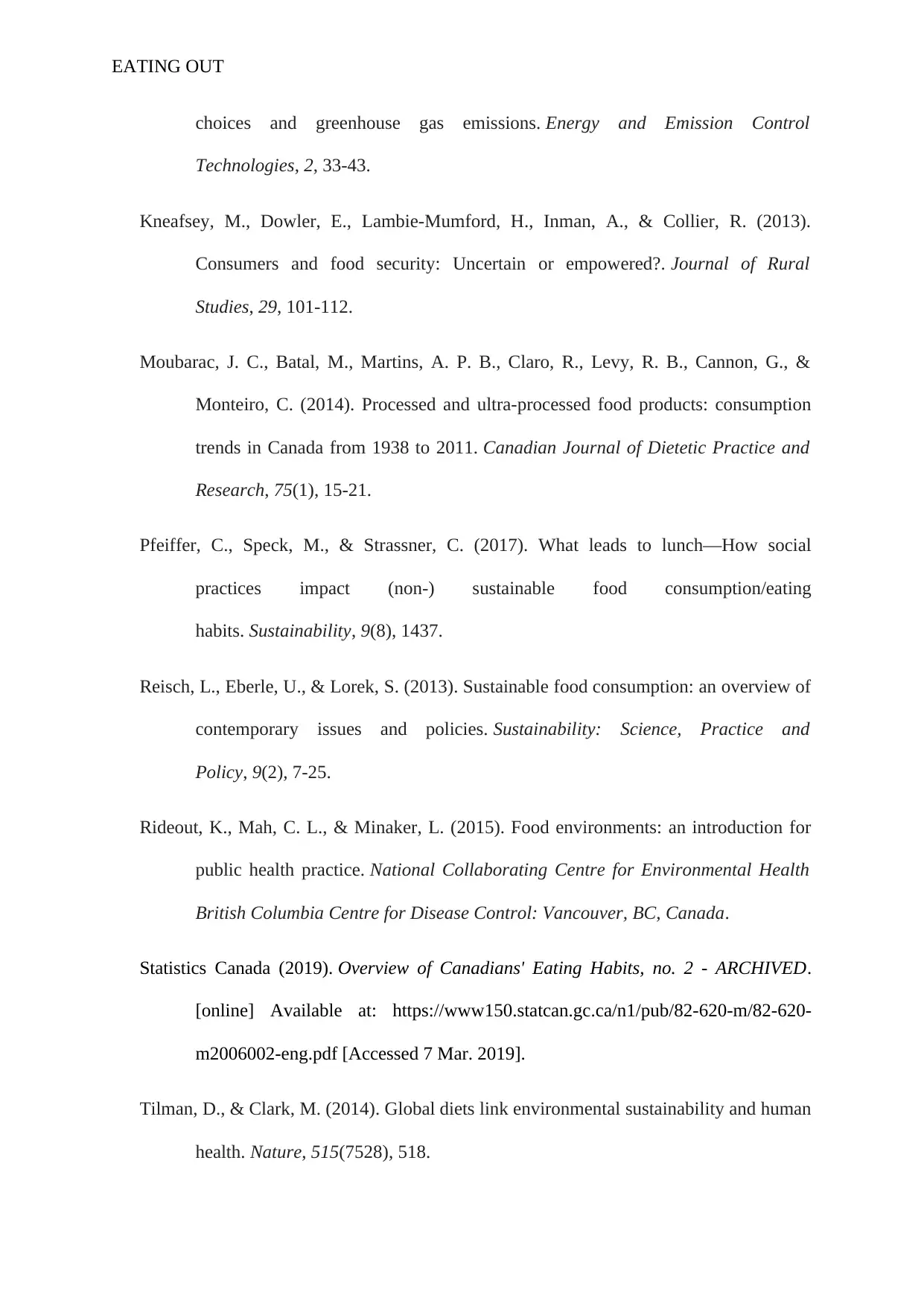
EATING OUT
choices and greenhouse gas emissions. Energy and Emission Control
Technologies, 2, 33-43.
Kneafsey, M., Dowler, E., Lambie-Mumford, H., Inman, A., & Collier, R. (2013).
Consumers and food security: Uncertain or empowered?. Journal of Rural
Studies, 29, 101-112.
Moubarac, J. C., Batal, M., Martins, A. P. B., Claro, R., Levy, R. B., Cannon, G., &
Monteiro, C. (2014). Processed and ultra-processed food products: consumption
trends in Canada from 1938 to 2011. Canadian Journal of Dietetic Practice and
Research, 75(1), 15-21.
Pfeiffer, C., Speck, M., & Strassner, C. (2017). What leads to lunch—How social
practices impact (non-) sustainable food consumption/eating
habits. Sustainability, 9(8), 1437.
Reisch, L., Eberle, U., & Lorek, S. (2013). Sustainable food consumption: an overview of
contemporary issues and policies. Sustainability: Science, Practice and
Policy, 9(2), 7-25.
Rideout, K., Mah, C. L., & Minaker, L. (2015). Food environments: an introduction for
public health practice. National Collaborating Centre for Environmental Health
British Columbia Centre for Disease Control: Vancouver, BC, Canada.
Statistics Canada (2019). Overview of Canadians' Eating Habits, no. 2 - ARCHIVED.
[online] Available at: https://www150.statcan.gc.ca/n1/pub/82-620-m/82-620-
m2006002-eng.pdf [Accessed 7 Mar. 2019].
Tilman, D., & Clark, M. (2014). Global diets link environmental sustainability and human
health. Nature, 515(7528), 518.
choices and greenhouse gas emissions. Energy and Emission Control
Technologies, 2, 33-43.
Kneafsey, M., Dowler, E., Lambie-Mumford, H., Inman, A., & Collier, R. (2013).
Consumers and food security: Uncertain or empowered?. Journal of Rural
Studies, 29, 101-112.
Moubarac, J. C., Batal, M., Martins, A. P. B., Claro, R., Levy, R. B., Cannon, G., &
Monteiro, C. (2014). Processed and ultra-processed food products: consumption
trends in Canada from 1938 to 2011. Canadian Journal of Dietetic Practice and
Research, 75(1), 15-21.
Pfeiffer, C., Speck, M., & Strassner, C. (2017). What leads to lunch—How social
practices impact (non-) sustainable food consumption/eating
habits. Sustainability, 9(8), 1437.
Reisch, L., Eberle, U., & Lorek, S. (2013). Sustainable food consumption: an overview of
contemporary issues and policies. Sustainability: Science, Practice and
Policy, 9(2), 7-25.
Rideout, K., Mah, C. L., & Minaker, L. (2015). Food environments: an introduction for
public health practice. National Collaborating Centre for Environmental Health
British Columbia Centre for Disease Control: Vancouver, BC, Canada.
Statistics Canada (2019). Overview of Canadians' Eating Habits, no. 2 - ARCHIVED.
[online] Available at: https://www150.statcan.gc.ca/n1/pub/82-620-m/82-620-
m2006002-eng.pdf [Accessed 7 Mar. 2019].
Tilman, D., & Clark, M. (2014). Global diets link environmental sustainability and human
health. Nature, 515(7528), 518.
⊘ This is a preview!⊘
Do you want full access?
Subscribe today to unlock all pages.

Trusted by 1+ million students worldwide
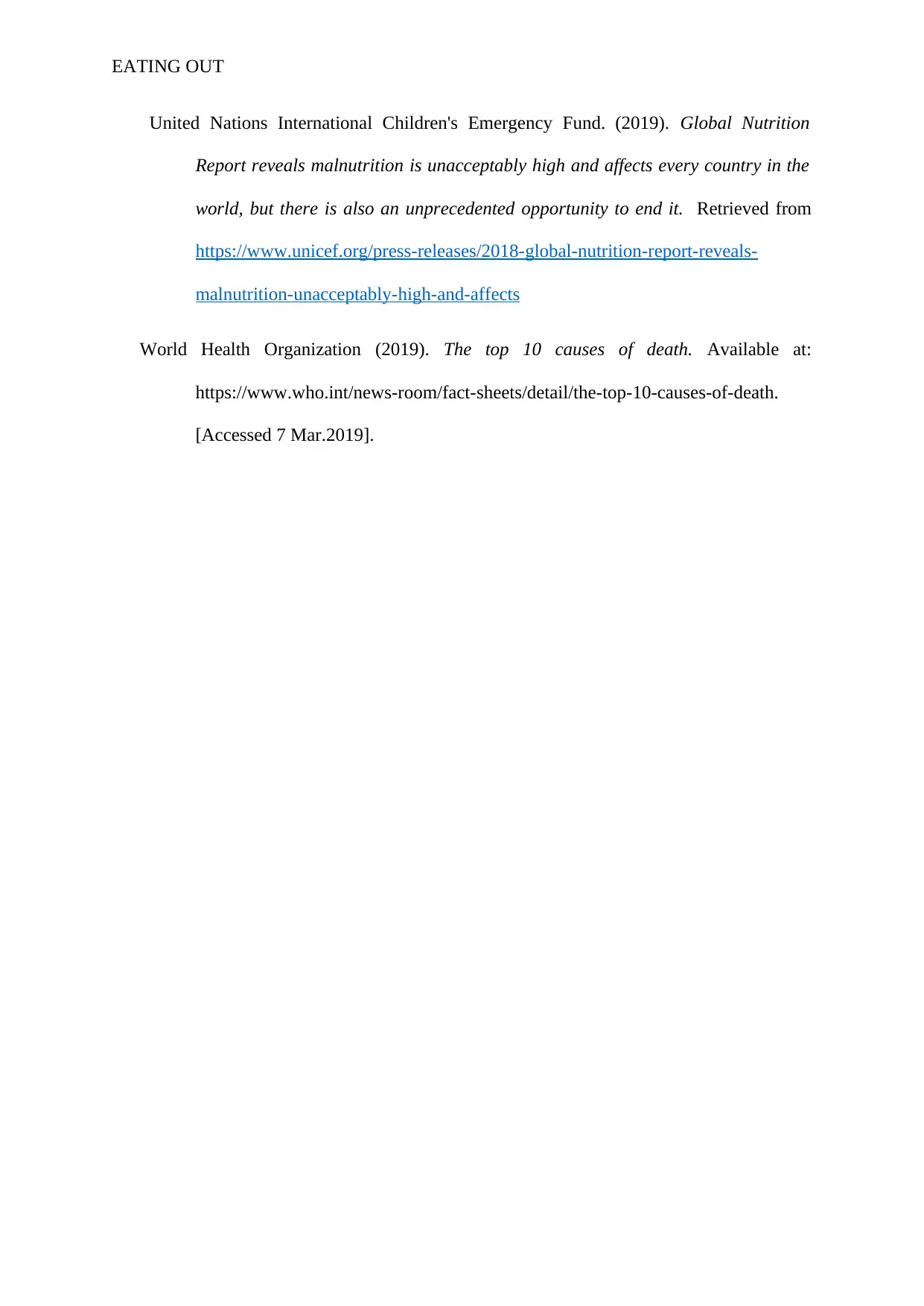
EATING OUT
United Nations International Children's Emergency Fund. (2019). Global Nutrition
Report reveals malnutrition is unacceptably high and affects every country in the
world, but there is also an unprecedented opportunity to end it. Retrieved from
https://www.unicef.org/press-releases/2018-global-nutrition-report-reveals-
malnutrition-unacceptably-high-and-affects
World Health Organization (2019). The top 10 causes of death. Available at:
https://www.who.int/news-room/fact-sheets/detail/the-top-10-causes-of-death.
[Accessed 7 Mar.2019].
United Nations International Children's Emergency Fund. (2019). Global Nutrition
Report reveals malnutrition is unacceptably high and affects every country in the
world, but there is also an unprecedented opportunity to end it. Retrieved from
https://www.unicef.org/press-releases/2018-global-nutrition-report-reveals-
malnutrition-unacceptably-high-and-affects
World Health Organization (2019). The top 10 causes of death. Available at:
https://www.who.int/news-room/fact-sheets/detail/the-top-10-causes-of-death.
[Accessed 7 Mar.2019].
1 out of 10
Related Documents
Your All-in-One AI-Powered Toolkit for Academic Success.
+13062052269
info@desklib.com
Available 24*7 on WhatsApp / Email
![[object Object]](/_next/static/media/star-bottom.7253800d.svg)
Unlock your academic potential
Copyright © 2020–2025 A2Z Services. All Rights Reserved. Developed and managed by ZUCOL.





